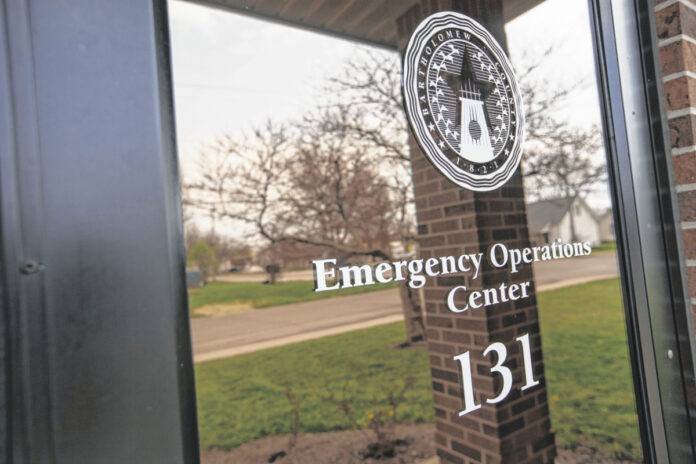COLUMBUS, Ind. — The first annual report from a public agency detailing the impact of COVID-19 in the Columbus area in 2020 shows emergency responses were up significantly due to medical emergencies from the virus.
The number of calls received by the Bartholomew County E911 Emergency Operations Center in 2020 was unbelievable, Bartholomew County Commissioner Tony London said.
In total, nearly 142,000 phone transactions were processed last year, center director Todd Noblitt told the commissioners. But rather than crimes or fires, the largest number of calls came from those seeking emergency medical services, at 8,829, the report states.
Last year, there was a record 2.7 million emergency radio transmissions made in the county, as well as a 12% increase in text-to-911 transactions at 4,732 throughout the year, Noblitt said.
In a section of the report titled “COVID, COVID and MORE COVID,” Noblitt and his deputy director, Julie Pierce, outlined how the virus impacted the operations center.
With the initial onset of the virus in February 2020, the center canceled training, travel and time-off for staff, Noblitt said. To reduce the number of dispatchers in one enclosed space, a second emergency dispatch center was temporarily installed at the Bartholomew County Governmental Office building.
The action was taken to ensure that a COVID-19 outbreak would not completely close down emergency dispatching, Noblitt said.
“The interesting thing is that during the initial outbreak (March, April, May), we actually saw a significant reduction of phone calls for service by 17%,” Noblitt said. In mid-May, all operations were brought back to the center at 131 S. Cherry St., and staff was again allowed to take time off.
But total calls began to pick up significantly in June, and were continuing on an upward trend when the second wave of COVID cases emerged in the fall, Noblitt said. By that time, $150,000 in grant money allowed equipment to be purchased for additional dispatching locations. For the second time last year, a secondary dispatch center was set up in the fall — this time at the Bartholomew County Sheriff’s Department, the report states.
In addition, local government officials invested $105,000 from their portion of federal CARES monies for mobile AT&T command locations, which allow 911 calls to be received at any local location, the report states. These units are able to provide critical information such as mapping and GPS coordinates for the caller, Noblitt said. In addition, they allow the E911 Center to increase the number of active and fully functioning dispatchers from seven to 11 in time of need, he said.
Although emergency dispatchers do not have direct contact with residents they assist, the E911 Center at 131 S. Cherry St. was not spared the consequences of the pandemic.
On the night before Thanksgiving, a dispatcher tested positive for COVID-19, the report states. Over the next few days, several staff members were tested because many were experiencing flu-like systems.
Although the E911 Center returned to full-staff on Dec. 5, managers were notified on Dec. 17 that another dispatcher tested positive for COVID, and six dispatchers may have been exposed to the virus. Two dispatchers were ultimately hospitalized, while the remaining five dispatchers were asymptomatic and required to report for duty as “critical infrastructure workers.”
At one point, the center had nine dispatchers (38% of staffing) out simultaneously, according to the report. Although the situation did have a significant impact on employee scheduling, Noblitt emphasized there was absolutely no interruption to operations.
Only two dispatchers left the department in 2020, and training was able to continue through video conferencing in such areas at active assailant/shooter situations or hostage negotiations. The department also worked with both local and state officials to plan and prepare for emergency responses in the event of local civil unrest, the report states.
Perhaps the most positive development came in April, when Indiana Gov. Eric Holcomb signed into legislation a mandate that identified 911 emergency dispatchers as first responders. This provides the dispatchers the same recognition, as well as some benefits, that are provided to law enforcement, firefighters and emergency medical services personnel.
But with the COVID pandemic still prevalent in the community, the center’s original plan to hire six new dispatchers from now through March will have to be postponed until the final quarter of 2021, Noblitt said.
While acknowledging the constantly growing responsibilities of dispatchers, Bartholomew County Commissioners chairman Larry Kleinhenz said he’s concerned that only about a fourth of local E911 calls were actual emergencies last year. As an example, the commissioner cited a 911 call from a resident who complained about trash in a road.
When Kleinhenz asked if there is any way to reduce non-emergency 911 calls, Noblitt said the increase in those types of calls are a consequence of the popularity of cell phones. Unfortunately, when they want to report anything, they immediately dial 911, he said.
“A lot of people understand their call is not an emergency, but they do need to speak to somebody, and we’re the ones who get the call,” Noblitt said. “We try to handle that as best as we can.”





